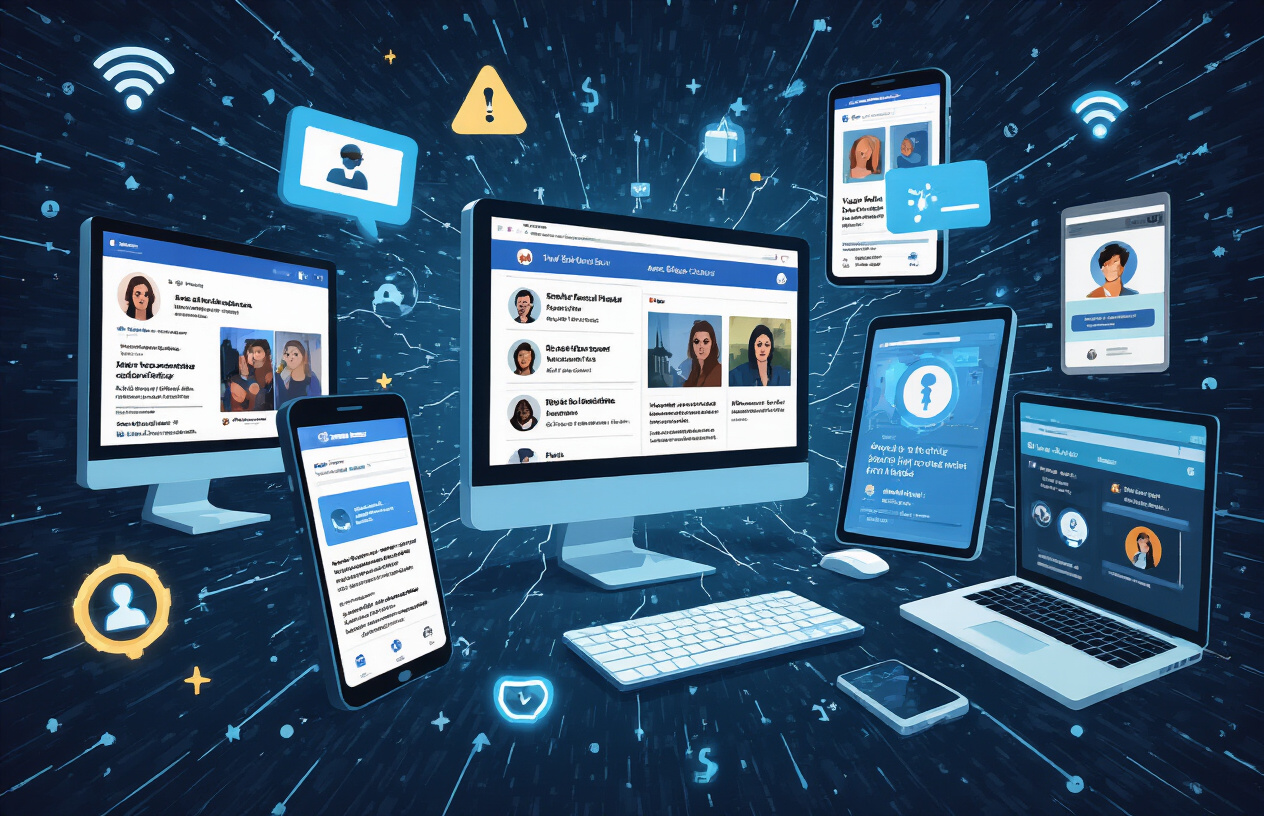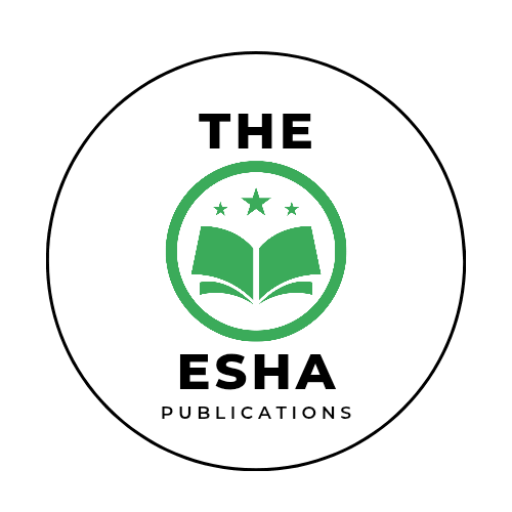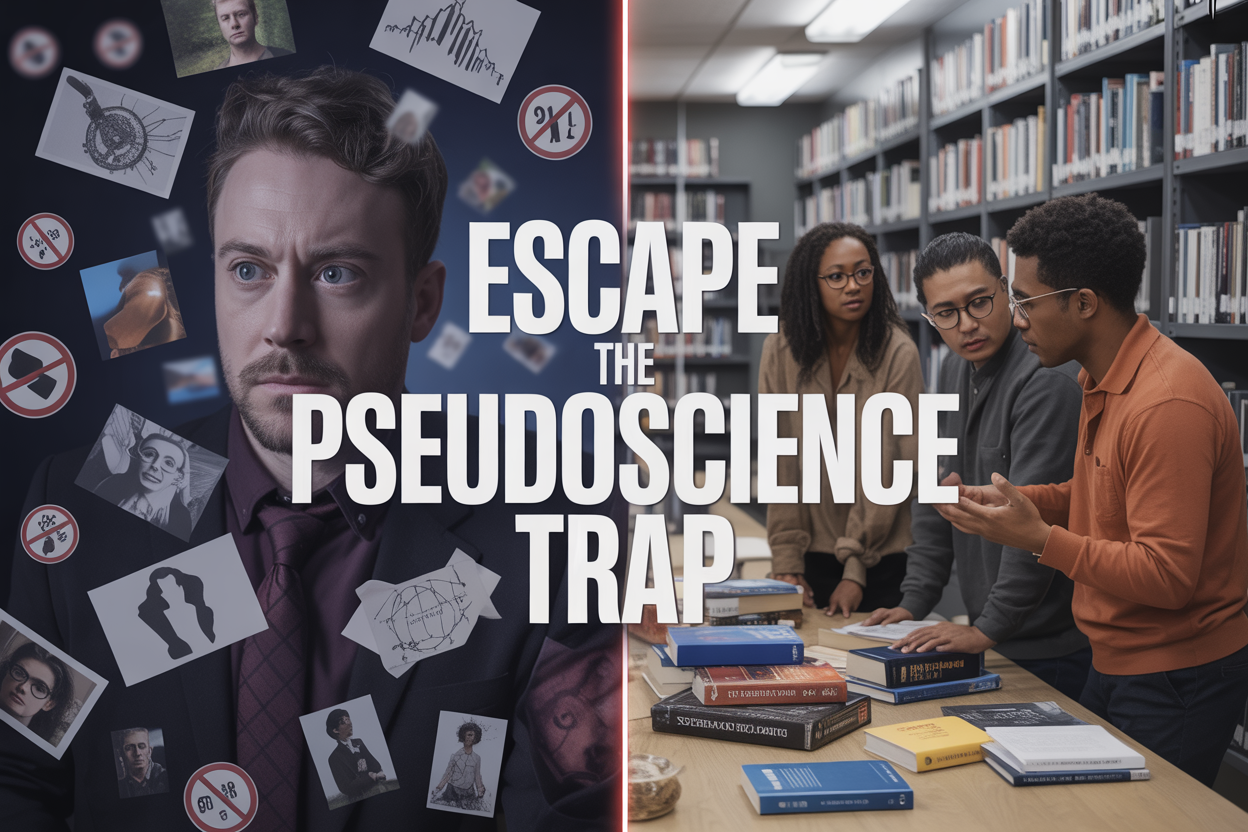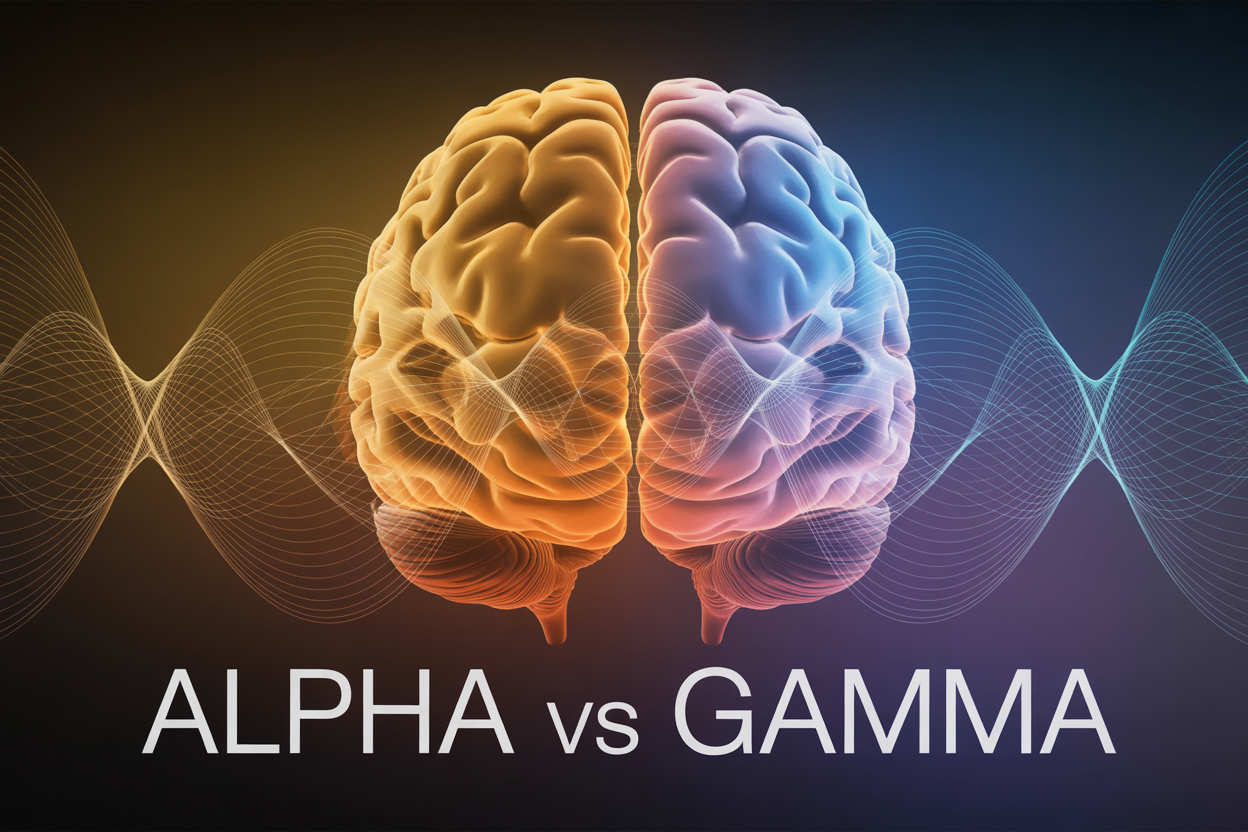The Pseudoscience Trap: How We Got Here and How to Get Out
We’re living in an age where pseudoscience spreads faster than actual science. From social media feeds packed with fake news to conspiracy theories that sound convincingly real, misinformation has become a daily challenge we all face.
This guide is for anyone who wants to sharpen their critical thinking skills and help others do the same – parents worried about what their kids see online, educators fighting an uphill battle against myths, or simply curious people who want to tell real science from clever-sounding nonsense.
We’ll dig into why our brains make us sitting ducks for pseudoscience and conspiracy theories, exploring the cognitive bias and psychological tricks that fool even smart people. You’ll also learn how the digital age has turned misinformation into a supercharged weapon, and most importantly, discover practical ways to build scientific literacy and skeptical thinking that actually work. Finally, we’ll explore how to create communities that value media literacy and resist the pull of debunking myths that never seem to die.
The goal isn’t to become a walking fact-checker, but to develop the mental tools that help you navigate our complicated information landscape with confidence.
Understanding the Modern Pseudoscience Crisis

Defining pseudoscience and its distinguishing characteristics
Pseudoscience masquerades as legitimate science while lacking the rigorous methodology and evidence-based foundation that real science demands. Unlike genuine scientific inquiry, pseudoscience relies on cherry-picked data, anecdotal evidence, and confirmation bias to support predetermined conclusions.
The hallmarks of pseudoscience include unfalsifiable claims that cannot be tested or disproven, resistance to peer review, and an over-reliance on testimonials rather than controlled studies. Practitioners often use scientific-sounding language to appear credible while avoiding the scrutiny that legitimate research undergoes. They frequently invoke conspiracy theories to explain why mainstream science rejects their claims, positioning themselves as misunderstood pioneers rather than acknowledging methodological flaws.
Real science embraces uncertainty, updates theories based on new evidence, and welcomes attempts to disprove hypotheses. Pseudoscience does the opposite – it presents absolute certainty, dismisses contradictory evidence, and attacks critics rather than addressing their concerns. This distinction matters because pseudoscientific beliefs can lead people to make harmful decisions about their health, finances, and safety.
Identifying the most prevalent pseudoscientific beliefs today
The digital age has given rise to numerous pseudoscientific movements that spread rapidly through social media and online communities. Anti-vaccine misinformation represents one of the most dangerous examples, with false claims linking vaccines to autism despite overwhelming scientific evidence to the contrary. This movement has contributed to outbreaks of preventable diseases like measles and whooping cough.
Alternative medicine practices without scientific backing continue to flourish, from homeopathy to energy healing. While some complementary approaches have legitimate research support, many capitalize on people’s desire for natural solutions without providing evidence of effectiveness. The supplement industry, largely unregulated, promotes countless products with exaggerated health claims.
Climate change denial persists despite scientific consensus, often funded by fossil fuel interests and amplified by conspiracy theories. Flat Earth beliefs have experienced an unexpected resurgence, demonstrating how even the most fundamental scientific facts can be questioned in echo chambers. Cryptocurrency and financial scams frequently use pseudoscientific claims about market predictions and “secret systems” to defraud investors.
QAnon and similar conspiracy theories blend pseudoscience with political beliefs, creating complex belief systems that resist debunking through traditional fact-checking methods.
Measuring the real-world impact on decision-making
Pseudoscience significantly influences major life decisions across healthcare, education, and personal relationships. Parents who believe vaccine misinformation may refuse to vaccinate their children, creating public health risks. People diagnosed with serious illnesses sometimes delay or abandon proven treatments in favor of unproven alternatives, with potentially fatal consequences.
Educational choices suffer when pseudoscientific beliefs override evidence-based practices. Some parents choose schools based on debunked learning theories or reject established curricula in favor of programs promoting pseudoscientific concepts. This impacts children’s scientific literacy and critical thinking development.
Financial decisions frequently fall prey to pseudoscientific thinking. Investment scams often use fake scientific backing to appear legitimate, while consumers spend billions on products with unsubstantiated health claims. Dating and relationship apps exploit psychological pseudoscience to promise perfect matches based on questionable compatibility algorithms.
The workplace isn’t immune either. Some companies adopt management practices based on debunked psychological theories or hire based on personality tests lacking scientific validity. Emergency preparedness suffers when communities trust pseudoscientific predictions over meteorological science or geological expertise.
Recognizing the financial cost to individuals and society
The economic impact of pseudoscience reaches staggering proportions. Americans alone spend over $40 billion annually on vitamins and supplements, many with no proven benefits. The homeopathic medicine market generates billions worldwide despite products containing no active ingredients beyond placebo effects.
Healthcare systems bear enormous costs when patients delay effective treatments for unproven alternatives. Cancer patients who initially choose alternative medicine have significantly higher mortality rates, creating both human tragedy and increased medical expenses for advanced-stage treatments. Vaccine-preventable disease outbreaks cost millions in emergency response, contact tracing, and treatment.
Cryptocurrency and investment fraud based on pseudoscientific claims costs individuals billions annually. The Federal Trade Commission reports that consumers lost over $5.8 billion to fraud in 2021, with many scams incorporating fake scientific backing to appear credible.
Environmental costs mount when pseudoscientific beliefs delay action on climate change or promote ineffective solutions. The economic impact of extreme weather events, partly attributable to climate inaction, reaches hundreds of billions annually in the United States alone.
Legal systems spend resources prosecuting fraud cases while regulatory agencies work to combat misleading health claims. Educational systems must allocate time and money to correct pseudoscientific misconceptions rather than advancing scientific literacy.
The hidden costs include lost productivity when employees make poor decisions based on pseudoscientific beliefs and the social fragmentation that occurs when communities split over contested scientific facts.
Psychological Vulnerabilities That Make Us Susceptible

Exploiting our natural pattern-seeking behavior
Humans are wired to find patterns everywhere. This built-in mental software helped our ancestors survive by quickly identifying threats and opportunities in their environment. When rustling leaves might signal a predator or specific cloud formations could predict weather changes, pattern recognition was literally a matter of life and death.
Today, this same hardwired tendency makes us sitting ducks for pseudoscience and misinformation. Our brains automatically connect dots that might not actually be connected, creating compelling narratives from random events. When someone develops cancer after living near power lines, we instinctively link the two events, even though correlation doesn’t equal causation.
Conspiracy theories exploit this vulnerability masterfully. They present complex world events as interconnected patterns orchestrated by hidden forces. This feels more satisfying than accepting that sometimes terrible things happen randomly or result from countless small factors we can’t easily track.
The problem gets worse when we encounter information overload. Our pattern-seeking brain goes into overdrive, trying to make sense of overwhelming data streams. Social media algorithms capitalize on this by serving up content that appears to reveal hidden connections, feeding our hunger for meaningful patterns even when those patterns are manufactured.
Leveraging confirmation bias for false validation
Confirmation bias acts like a mental filter that lets in information supporting what we already believe while blocking out contradictory evidence. This cognitive bias doesn’t just influence our opinions about politics or personal preferences—it actively shapes how we process scientific information and evaluate truth claims.
Pseudoscience peddlers understand this psychological weakness intimately. They craft their messages to align perfectly with existing beliefs, fears, and desires. Anti-vaccine content doesn’t start by attacking vaccines directly. Instead, it begins with seemingly reasonable concerns about pharmaceutical companies or government overreach—topics that resonate with people’s existing skepticism about institutions.
Online echo chambers amplify this effect exponentially. Search engines and social platforms use sophisticated algorithms to show us content similar to what we’ve previously engaged with. If you click on one alternative health article, you’ll soon find your feeds flooded with similar content that reinforces those initial leanings.
The validation feels real and meaningful. When multiple sources appear to confirm our suspicions, we experience a powerful psychological reward. Our brains interpret this artificial consensus as evidence that we’re thinking clearly and seeing through mainstream deceptions. This creates an addictive cycle where seeking out confirming information becomes emotionally satisfying rather than intellectually honest.
Capitalizing on our fear of uncertainty and complexity
Uncertainty makes humans deeply uncomfortable. We’d rather have wrong answers than no answers at all. This psychological quirk creates fertile ground for pseudoscientific explanations that promise simple solutions to complex problems.
Modern life overwhelms us with intricate systems we don’t fully understand. Climate science involves countless variables interacting across decades. Medical research requires understanding statistics, study design, and biological mechanisms that take years to master. Economic forces shape our daily lives through processes most people find bewildering.
Pseudoscience offers relief from this cognitive burden. Instead of grappling with messy, incomplete scientific understanding, it provides clean, definitive explanations. Vaccines cause autism. Essential oils cure cancer. Government weather machines control climate. These claims feel satisfying because they reduce overwhelming complexity into digestible narratives with clear villains and heroes.
Fake news and misleading health information spread fastest during times of heightened uncertainty—pandemics, economic crises, or social upheaval. When people feel overwhelmed by forces beyond their control, they become more receptive to explanations that restore a sense of understanding and agency, even when those explanations are demonstrably false.
The fear of admitting ignorance also plays a crucial role. Saying “I don’t know” or “the science is still developing” feels like intellectual weakness. Pseudoscience eliminates this discomfort by providing confident answers that sound authoritative enough to repeat in conversations, making people feel knowledgeable and informed.
Digital Age Amplifiers Spreading Misinformation

Social media algorithms creating echo chambers
Social media platforms have become breeding grounds for pseudoscience and misinformation, largely due to their engagement-driven algorithms. These systems prioritize content that generates strong emotional responses, shares, and comments – exactly the type of reaction that sensational pseudoscientific claims provoke. When someone clicks on a conspiracy theory video or shares a post about miracle cures, the algorithm interprets this as interest and serves up more similar content.
The result creates what researchers call filter bubbles – personalized information ecosystems where users primarily encounter content that confirms their existing beliefs. A person who shows interest in alternative medicine might find their feed flooded with anti-vaccine content, crystal healing promotions, and articles questioning mainstream medical science. Meanwhile, evidence-based medical information becomes increasingly rare in their digital environment.
These echo chambers don’t just reinforce existing beliefs; they actively radicalize them. As users move deeper into pseudoscientific communities online, they encounter increasingly extreme claims presented as normal discourse. What starts as curiosity about natural health remedies can evolve into complete rejection of conventional medicine through algorithmic amplification of progressively more radical content.
The democratization of publishing without peer review
The internet has eliminated traditional barriers to publishing, allowing anyone with an internet connection to present themselves as an expert. While this democratization has many benefits, it has also created a landscape where pseudoscientific content often appears alongside legitimate research, making it difficult for average readers to distinguish between the two.
Platforms like Medium, Substack, and personal blogs allow individuals to publish professional-looking articles without any editorial oversight or fact-checking. Pseudoscience promoters exploit this by mimicking the format and language of scientific publications, complete with citations (often to other dubious sources) and impressive-sounding credentials.
YouTube and podcast platforms have become particularly problematic venues for spreading misinformation. Content creators can produce hours of material that sounds authoritative, complete with charts, graphs, and scientific terminology, without any requirement for accuracy or peer review. These formats are especially dangerous because they allow charismatic speakers to build parasocial relationships with their audiences, increasing trust and reducing critical evaluation of claims.
The speed of digital publishing also means that pseudoscientific content can spread globally before fact-checkers or experts have time to respond. By the time debunking articles appear, the misinformation has often already gone viral and become embedded in online communities.
Viral marketing techniques used by pseudoscience promoters
Pseudoscience promoters have mastered the art of viral marketing, using sophisticated techniques borrowed from legitimate advertising and social media marketing. They understand that fear, hope, and outrage drive engagement, so they craft content specifically designed to trigger these emotions.
Clickbait headlines promise revolutionary discoveries that “doctors don’t want you to know” or reveal “shocking truths” about familiar products or treatments. These emotional hooks bypass rational thinking and encourage immediate sharing before readers have time to critically evaluate the content.
Many pseudoscience promoters use influencer marketing strategies, partnering with social media personalities who may not have scientific backgrounds but have large, trusting audiences. These influencers often present pseudoscientific products or ideas as lifestyle choices rather than medical claims, making them seem more relatable and less suspicious to followers.
The use of manufactured urgency is another common tactic. Promoters create artificial scarcity with messages like “limited time offer” or “this information is being suppressed,” encouraging quick decisions and sharing before the content is “taken down.” This manufactured urgency prevents careful consideration and fact-checking.
The erosion of traditional gatekeepers and authority
Traditional institutions that once served as gatekeepers for scientific information – universities, medical journals, established media outlets – have seen their authority diminished in the digital age. While these institutions weren’t perfect and sometimes did suppress legitimate dissent, they provided quality control that’s largely absent from today’s information landscape.
The decline in local journalism has eliminated many science reporters who once served as intermediaries between complex research and public understanding. These journalists were trained to ask critical questions, seek expert opinions, and present balanced coverage of scientific topics. Their replacement by algorithm-driven news aggregation and citizen journalism has created gaps that pseudoscience promoters readily exploit.
Many people now get their scientific information from social media rather than established sources, creating opportunities for bad actors to position themselves as alternative authorities. They present themselves as brave truth-tellers fighting against corrupt establishments, appealing to anti-institutional sentiment while offering simple explanations for complex problems.
The fragmentation of authority has made it easier for individuals to shop around for information sources that confirm their preferences rather than challenge them with evidence-based perspectives. This authority shopping reinforces existing beliefs and makes people more susceptible to pseudoscientific claims that align with their worldview.
Historical Patterns of Pseudoscience Emergence

Economic Uncertainty Driving Magical Thinking
When times get tough financially, people naturally look for explanations and solutions beyond conventional wisdom. History shows us this pattern repeatedly. During the Great Depression, fortune telling, astrology, and get-rich-quick schemes flourished as desperate families sought hope and control over their circumstances.
Economic downturns create fertile ground for pseudoscience because they shake our confidence in established systems. When banks fail, jobs disappear, and traditional investments crumble, people become more willing to embrace alternative explanations for their struggles. This vulnerability opens doors to conspiracy theories about secret cabals manipulating markets or magical thinking that promises quick financial recovery through crystals, manifestation techniques, or dubious investment schemes.
The 2008 financial crisis perfectly illustrates this pattern. As foreclosures mounted and unemployment soared, conspiracy theories about banking elites gained traction alongside alternative health movements promising expensive “detox” solutions for stress-related ailments. Social media amplified these trends, creating echo chambers where economic anxiety mixed with pseudoscientific explanations.
Modern gig economy pressures and inflation concerns continue this cycle. When people feel financially unstable, they’re more likely to fall for cryptocurrency scams disguised as revolutionary technology, multi-level marketing schemes promising financial freedom, or investment advice from unqualified social media influencers. The psychological need for control during uncertain times makes us vulnerable to anyone offering simple explanations or guaranteed solutions.
Scientific Literacy Gaps Creating Knowledge Voids
The widening gap between scientific advancement and public understanding creates dangerous spaces where misinformation thrives. Complex topics like climate science, genetics, and quantum physics require years of study to truly comprehend, yet most people encounter these subjects only through simplified media coverage or social media posts.
This knowledge vacuum becomes a breeding ground for pseudoscience. When people don’t understand how vaccines work, they become susceptible to anti-vaccination propaganda. When they can’t grasp statistical analysis, they fall for misleading health claims backed by cherry-picked data. The complexity of modern science intimidates many people, making them more likely to trust charismatic personalities who offer oversimplified explanations.
Educational systems often compound this problem by teaching science as a collection of facts rather than a method of inquiry. Students memorize formulas without learning how to evaluate evidence or spot logical fallacies. This approach leaves them unprepared to navigate the sophisticated misinformation campaigns they’ll encounter as adults.
The rise of scientific jargon in marketing exploits these literacy gaps. Products claiming to use “quantum energy” or “structured water” sound impressive to consumers who recognize the scientific terms but don’t understand their actual meaning. Skilled pseudoscience promoters deliberately use legitimate scientific vocabulary to lend credibility to baseless claims.
Authority Distrust Leading to Alternative Explanations
Growing skepticism toward traditional authorities creates opportunities for pseudoscience to position itself as the rebellious truth-teller. When people lose faith in government institutions, medical establishments, or academic experts, they actively seek alternative sources of information that confirm their suspicions about official narratives.
This distrust often has legitimate roots. Historical examples of institutional failures, corporate cover-ups, and expert mistakes provide ammunition for those promoting pseudoscientific alternatives. The tobacco industry’s decades-long campaign denying smoking’s health risks, pharmaceutical companies downplaying addiction risks, and government agencies making contradictory statements during health crises all contribute to public cynicism about official expertise.
Pseudoscience movements capitalize on this distrust by framing themselves as grassroots resistance against corrupt elites. They present their unsubstantiated claims as suppressed truths that powerful interests don’t want the public to know. This narrative appeals to people who feel marginalized or ignored by mainstream institutions.
Social media algorithms amplify anti-authority sentiments by connecting like-minded skeptics and creating the illusion of widespread dissent against established knowledge. Online communities form around shared distrust, reinforcing members’ beliefs that they possess special insight while experts remain clueless or complicit in deception.
The challenge becomes distinguishing between healthy skepticism and destructive cynicism. While questioning authority can be valuable, wholesale rejection of expertise leaves people vulnerable to charlatans who exploit their distrust for personal gain.
Building Critical Thinking Skills for Protection

Developing Source Evaluation Techniques
The internet floods us with information from countless sources, making source evaluation your first line of defense against pseudoscience. Start by checking who’s behind the content you’re reading. Look for author credentials, institutional affiliations, and publication history. Credible sources clearly identify their authors and provide contact information.
Examine the publication itself. Peer-reviewed journals follow rigorous review processes, while personal blogs or websites with flashy designs often lack editorial oversight. Check if the source cites other reputable publications and studies. Quality information builds on existing research rather than making isolated claims.
Watch for red flags like sensational headlines, emotional language, or claims that seem too good to be true. Legitimate scientific content presents findings with appropriate caveats and limitations. Cross-reference information across multiple reliable sources before accepting claims as fact.
Consider the source’s funding and potential conflicts of interest. Organizations with clear agendas may present biased information that supports their goals rather than objective truth.
Learning to Identify Logical Fallacies in Arguments
Logical fallacies are reasoning errors that undermine arguments, and pseudoscience promoters use them constantly. Recognizing these patterns helps you spot weak reasoning immediately.
Ad hominem attacks target the person making an argument rather than addressing the argument itself. When someone dismisses scientific consensus by calling researchers “corrupt” without evidence, they’re using this fallacy.
The straw man fallacy misrepresents opposing positions to make them easier to attack. Climate change deniers often claim scientists believe humans control all weather patterns, then attack this exaggerated position.
Appeal to authority occurs when arguments rely on celebrity endorsements or unqualified experts. A famous actor promoting a health supplement carries no scientific weight.
False dichotomy presents only two options when many exist. “Either you accept this alternative treatment or you’ll die from conventional medicine” ignores the complexity of medical decisions.
Cherry-picking involves selecting only favorable evidence while ignoring contradictory data. This tactic appears frequently in conspiracy theories that highlight anomalies while dismissing overwhelming counter-evidence.
Practicing Evidence-Based Reasoning Methods
Evidence-based reasoning forms the backbone of scientific literacy. Start by distinguishing between different types of evidence and their relative strength. Anecdotal evidence from personal experiences carries less weight than controlled studies involving hundreds of participants.
Learn to evaluate study design and methodology. Randomized controlled trials provide stronger evidence than observational studies. Sample size matters too – conclusions drawn from small groups may not apply broadly.
Understand statistical concepts like correlation versus causation. Just because two events occur together doesn’t mean one causes the other. Many pseudoscientific claims exploit this common misunderstanding.
Look for replication in research. Single studies, regardless of quality, don’t establish scientific truth. Multiple independent studies reaching similar conclusions provide much stronger evidence.
Practice proportional thinking by matching your confidence in claims to the strength of supporting evidence. Extraordinary claims require extraordinary evidence, as Carl Sagan famously noted.
Cultivating Intellectual Humility and Curiosity
Intellectual humility means recognizing the limits of your knowledge and remaining open to changing your mind when presented with compelling evidence. This mindset protects against the overconfidence that makes people vulnerable to pseudoscience.
Question your existing beliefs regularly. Ask yourself what evidence might change your mind about topics you feel strongly about. If you can’t imagine any evidence that would shift your position, you might be thinking ideologically rather than scientifically.
Embrace uncertainty as natural and healthy. Science progresses through acknowledging what we don’t know and working to find answers. Pseudoscience often appeals to people by offering false certainty about complex topics.
Cultivate curiosity by asking “how do we know this?” when encountering new information. Trace claims back to their original sources and evidence. This practice helps you distinguish between well-supported facts and speculation.
Seek out perspectives that challenge your views, but do so thoughtfully. Engage with high-quality opposing arguments rather than weak versions that are easy to dismiss. This approach strengthens your critical thinking skills and helps you understand complex issues more completely.
Remember that changing your mind based on new evidence demonstrates intellectual strength, not weakness. The goal isn’t to be right all the time but to align your beliefs with the best available evidence.
Creating Pseudoscience-Resistant Communities

Establishing science communication best practices
Building communities that resist pseudoscience starts with how we share scientific knowledge. Scientists and communicators need to drop the jargon and speak like real people. When research stays locked behind academic paywalls and technical language, it creates a vacuum that misinformation rushes to fill.
Effective science communication means meeting people where they are. Instead of lecturing from ivory towers, scientists should engage on social media, local news, and community events. The best communicators use stories, analogies, and visuals that stick in people’s minds. They acknowledge uncertainty without undermining confidence in scientific methods.
Key strategies include:
- Proactive engagement: Scientists sharing their work before misinformation spreads
- Multiple platforms: Using podcasts, videos, infographics, and interactive content
- Cultural sensitivity: Adapting messages for different communities and backgrounds
- Two-way dialogue: Listening to public concerns and addressing them directly
- Clear uncertainty communication: Explaining what we know, don’t know, and how we find out
Media outlets play a crucial role too. They need to stop presenting false balance—giving equal weight to established science and fringe theories. Quality journalism requires distinguishing between legitimate scientific debate and manufactured controversy.
Supporting quality education initiatives
Strong educational foundations create the best defense against pseudoscience. This means investing in science education that goes beyond memorizing facts. Students need hands-on experience with the scientific method, learning how to ask good questions and evaluate evidence.
Critical thinking skills and scientific literacy should start early and continue throughout life. Schools need resources for inquiry-based learning, where students design experiments and analyze real data. This approach helps people understand that science is a process, not just a collection of facts.
Adult education matters just as much. Public libraries, community colleges, and online platforms can offer workshops on media literacy and scientific reasoning. These programs should focus on practical skills like:
- Evaluating sources: Checking credentials, funding, and peer review status
- Spotting red flags: Recognizing conspiracy thinking patterns and logical fallacies
- Understanding statistics: Interpreting data, correlation versus causation, and sample sizes
- Recognizing cognitive bias: How our brains trick us into believing comfortable lies
Teachers need support too. Professional development programs should help educators address pseudoscience in their classrooms confidently. When students bring up conspiracy theories or debunking myths, teachers need tools to respond constructively rather than dismissively.
Promoting transparent peer review processes
Peer review often feels like a black box to the public, creating distrust and feeding conspiracy theories about scientific gatekeeping. Making this process more transparent helps people understand how scientific consensus develops and why it deserves respect.
Open peer review, where reviewer comments become public alongside published papers, shows the rigorous scrutiny that legitimate research faces. This transparency reveals how scientists challenge each other’s work and refine ideas through collaboration and debate.
Transparency improvements include:
- Public review comments: Showing how papers get improved through feedback
- Reviewer identification: Moving away from anonymous reviews when possible
- Decision explanations: Clear reasoning for acceptance or rejection
- Preprint discussions: Public commentary on early research drafts
- Conflict of interest disclosure: Full transparency about funding and relationships
Scientific journals need to embrace digital tools that make peer review faster and more inclusive. Traditional publishing models create artificial scarcity and delay that pseudoscience exploits. When legitimate research takes months to appear while fake news spreads instantly, misinformation gets a head start.
Community involvement in science evaluation can also help. Citizen science projects and public research discussions create investment in scientific processes. When people participate in generating knowledge, they better understand its value and limitations.
The goal isn’t perfect transparency—some aspects of peer review require confidentiality. But opening up appropriate parts of the process builds public trust while maintaining scientific rigor.

Our brains weren’t built for the information age, and pseudoscience knows exactly how to exploit our mental shortcuts. The same pattern recognition that helped our ancestors survive now makes us see connections that aren’t there, while social media algorithms feed us exactly what we want to hear. History shows us this isn’t new – every major social shift brings its own wave of false beliefs, from the spiritualism craze of the Industrial Revolution to today’s wellness misinformation.
The good news? We’re not powerless against this tide. Strong critical thinking skills act like a mental immune system, helping us spot red flags like cherry-picked data, emotional manipulation, and claims that sound too good to be true. But individual defense isn’t enough – we need communities that value evidence over emotion and create safe spaces for people to question their beliefs without losing face. Start by questioning your own assumptions, fact-checking before sharing, and having patient conversations with friends and family who’ve fallen down pseudoscience rabbit holes. The fight against misinformation begins with each of us taking responsibility for what we believe and share.









